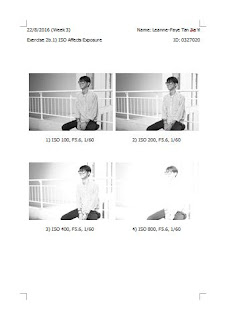Intro To Photography - Week 3
21/08/2016 - Week 3
ITP
Leanne Faye
Exercise 2b) ISO: 2b.1 & 2b.2
Exercise 2c) Shutter Speed
Lecture:
In today's lecture, Mr. Vinod started of by giving feedback for our e-portfolios. Then, we started out by having a short recap from last's weeks lecture on aperture. Then moving on to the lecture on shutter speed and ISO. The lecture was lengthy because we had to cover 2 components that affects exposure. It was clear for me to understand because I watched a few videos and read a few reading materials about shutter speed and ISO provided by Mr. Vinod on TIMeS few days before the lecture. During the lecture, I compared the notes I wrote down while watching the videos with what Mr. Vinod was saying so that I can keep up and not miss any important points.
Mr. Vinod asked us to refer or look at each other's blog and maybe learn a thing or two because we can get to know different styles of writing and learn each other's opinions and reflections. At the end of a blog posts, we can also add in a screengrab of our answer to the question in the forum.
After the lecture, we were given time to go out to do exercise 2c.1: to prove ISO affect exposure and exercise 2c.2: to prove ISO affect the quality of the image. When we came back, Mr. Vinod assigned us exercise 2b: show evidence that of shutter speed's ability can freeze fast moving objects or blur moving objects. This exercise is a take-home exercise as we have to shoot pictures of our fan using different shutter speed.
Learning outcome 1: Students will be able to use exposure settings (Aperture, Shutter Speed & ISO).
Learning outcome 3: Students will be able to distinguish a bad exposure from a good exposure.
Learning outcome 1: Students will be able to use exposure settings (Aperture, Shutter Speed & ISO).
Learning outcome 3: Students will be able to distinguish a bad exposure from a good exposure.
1)
Recorded audio on-the-spot




























0 comments